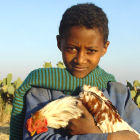June 29, 2012 • 6:35

On a tour, noted yesterday REFORM workers removing dead birds from a farm in Acatic and then incinerated.
Guadalajara. - Authorities say a peep and producers when challenged about the extent of spread of avian influenza A H7N3 that have occurred in farms and Acatic Tepatitlan, Jalisco.
The National Health Service, Food Safety and Food Quality (SENASICA) revealed on 21 June that evidence of the virus were detected in 4 of 110 poultry farms in the state, so a fence was installed sanitary and quarantine applies a precaution.
On Wednesday, indicated that they had sacrificed SENASICA 200 000 birds and is awaiting the arrival of one million vaccines purchased in Asia. These are the only official data that have been revealed.
On a tour, noted yesterday REFORM workers pulling the dead birds of at least three pens of egg producer located in the Municipality of Acatic, a few meters from the highway Guadalajara-Lagos de Moreno.
Without life, the animals are thrown into three tractors and a dump truck, meters after take them to a pit and burned.
One of the locals, who declined to give his name said that this movement began two weeks ago. He explained that the culling is done during the day as at night the workers leave the company and only the watchmen stay tuned for the facility.
Another worker, who also kept anonymity, confirmed that only this week on the farm for which works have been slaughtered around 20 000 birds.
"The kill and bury from first yes the were burning but no longer right now, walk around the control, but say that wherever it is well watered," he said.
It is estimated that the state exists in a universe poultry over 80 million, and in the affected municipalities, up to 12 million.
Evade authorities and producers provide daily records of the number of infected birds or slaughtered to enable to measure the problem in Jalisco, which is the main egg-producing state nationally, with 45 000 cases a day.
Poultry entrepreneurs interviewed were tight, but the reporter off the recorder, admitted that "it is a serious problem" even one of them said that this situation continues in a month lose all his chickens. Although the measures implemented by the SENASICA have been circulated since last week, producers of the place say that the outbreak was detected earlier this month.
The SENASICA has indicated that there is a strengthening of animal health measures in the area, but until yesterday, inspection modules was not installed any person, in some cases, staff said that there was no contingency in the area.
Enrique Sánchez Cruz, chief of SENASICA, said that the results of the farms that have been inspected will be available towards the following weekend.
Poultry producers are considered as a first step the import of one million doses of a vaccine specifically authorized and SENASICA-from Asia, which would today.
Sanchez Cruz said Mexican scientists are already working on developing a vaccine itself.
After the announcement of infections, the price of eggs has become more expensive nationwide: June 26, the price of tilefish was 15.80 pesos per kilo and yesterday stood at 22.50, according to the Ministry of Economy.
According to the SENASICA, the A H7N3 is not contagious to humans.
http://noticias.terra.com.mx/mexico/estados/jalisco/autoridades-no-dicen-ni-pio-sobre-gripe-aviar-en-jalisco,2a2dc1aa10838310VgnVCM3000009acceb0aRCRD.html




 Staff Writer
Staff Writer
